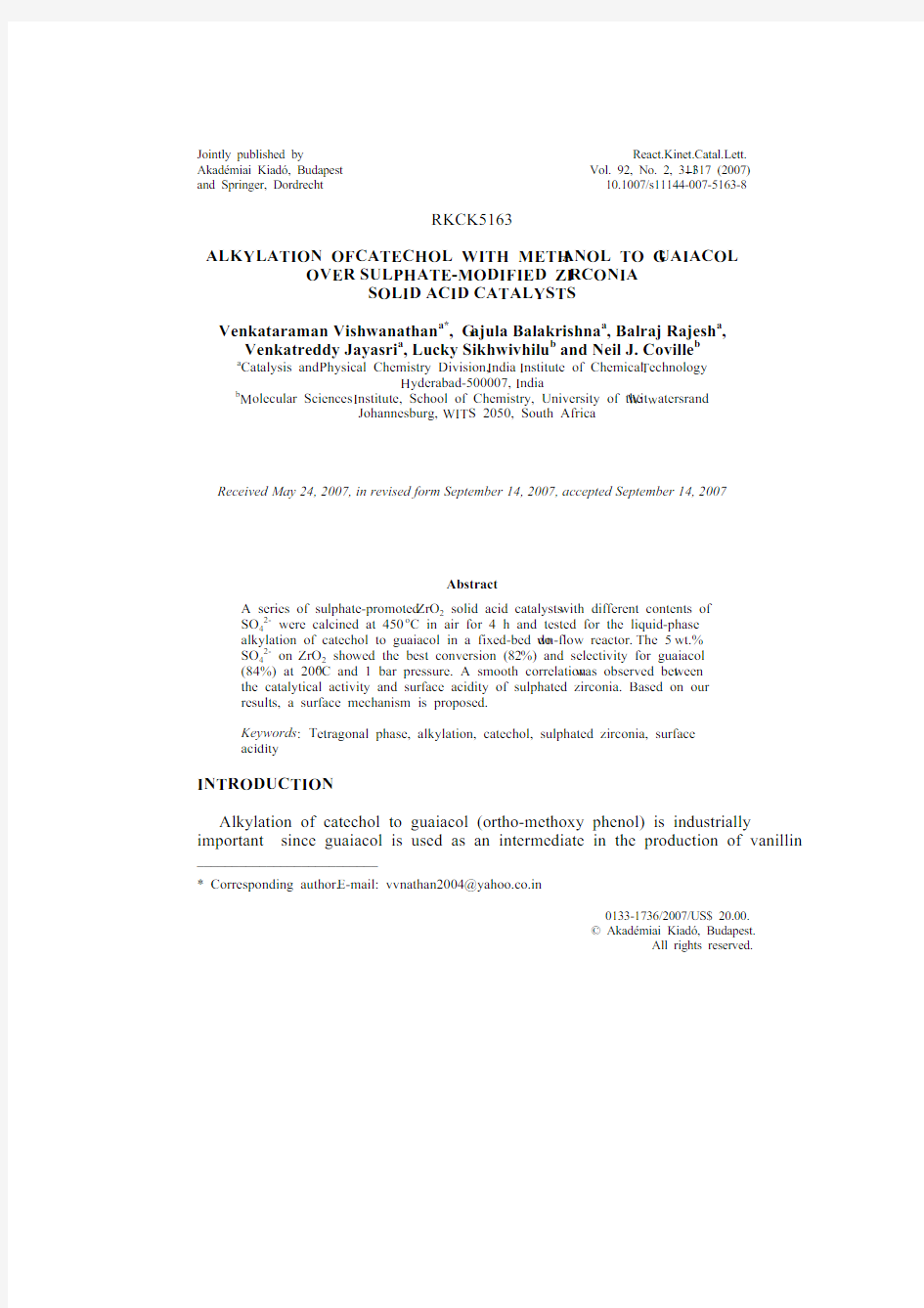
固体酸催化
- 格式:pdf
- 大小:161.39 KB
- 文档页数:7


Jointly published by
React.Kinet.Catal.Lett. Akadémiai Kiadó, Budapest
Vol. 92, No. 2, 311−317 (2007) and Springer, Dordrecht 10.1007/s11144-007-5163-8
0133-1736/2007/US$ 20.00.
© Akadémiai Kiadó, Budapest.
All rights reserved.
RKCK5163
ALK Y LA TIO N OF CA TE C HO L WITH METH AN O L TO G UA I AC O L
O V E R SUL PH A TE -MO D IFIE D ZI RC O N I A
S O L I D AC I D CA T AL Y S T S
Venkataraman Vish w anathan a *, G a j ula Balakrishna a , Balra j Ra j esh a ,
Venkatreddy Jayasri a , Lucky Sikh w ivhilu b and Neil J. Coville b
a
Catalysis and P hysical Chemistry Division, I ndia I nstitute of Chemical T echnology
H yderabad-500007, I ndia b M olecular Sciences I nstitute, School of Chemistry, University of the W it w atersrand
Johannesburg, WIT S 2050, South Africa
Received May 24, 2007, in revised form September 14, 2007, accepted September 14, 2007
A bstract
A series of sulphate-promoted Z r O 2 solid acid catalysts w ith different contents of
S O 42- w ere calcined at 450o C in air for 4 h and tested for the liquid-phase
alkylation of catechol to guaiacol in a fixed-bed do w n-flo w reactor. T he 5 w t.%
S O 42- on Z r O 2 sho w ed the best conversion (82%) and selectivity for guaiacol
(84%) at 200o C and 1 bar pressure. A smooth correlation w as observed bet w een
the catalytical activity and surface acidity of sulphated zirconia. Based on our
results, a surface mechanism is proposed.
Key w ords : T etragonal phase, alkylation, catechol, sulphated zirconia, surface
acidity
I N T R O DUC TIO N
Alkylation of catechol to guaiacol (ortho-methoxy phenol) is industrially
important since guaiacol is used as an intermediate in the production of vanillin
__________________________
* Corresponding author. E -mail: vvnathan2004@yahoo.co.in
31 V I S HW ANA TH AN et al.: TET RA GO NAL PH AS E [1]. T raditionally, guaiacol is synthesized by methylation of catechol w ith dimethylsulphate [2] or w ith a methyl halide in the presence of sodium hydroxide [3]. T hese methylating agents are expensive, corrosive and environmentally hazardous. H ence, there is a need to look for eco-friendly catalysts sho w ing higher activity and good selectivity for guaiacol. I n recent years, several solid acid catalysts have been tried out for various alkylation reactions. Some of the solid acid catalysts studied for the title reaction w ere metal oxides [4-9], phosphates [10,11], ammonium metatungstate [12] and zeolites [13]. H o w ever, information on the alkylation of catechol over sulphate-modified zirconia (S Z) is rather limited [14,15]. I n this communication, w e have reported for the first time a liquid-phase alkylation reaction of catechol w ith methanol to guaiacol over sulphated zirconia (S O42-/Z r O2) in a fixed-bed do w n-flo w reactor at 200o C under atmospheric pressure.
EXPE R IME N T AL
Z irconium hydroxide, Z r(OH)4, w as prepared by the hydrolysis of zirconium oxychloride (Z r O Cl2⋅8H2O; L O BA C HE M IE) w ith an aqueous ammonia solution (25 w t.%) at a constant p H of 10.5. T he precipitate w as filtered and w ashed w ith deionised w ater until no chloride ion w as detected in the filtrate. I t w as dried at 110o C for 24 h. A series of zirconia samples containing different w t.% of sulphate ions (S Z) w ere prepared by impregnating Z r(OH)4w ith an aqueous solution of appropriate amounts of ammonium sulphate. T he samples w ere dried at 110o C for 24 h and calcined at 450o C in air for 4 h.
T he surface areas of zirconia and sulphated zirconia samples w ere measured by Quantasorb AS-1 using N2 as a probe molecule. TP D of N H3w as used to measure the surface acidity of the samples.
T he liquid-phase reaction w as carried out in a fixed-bed glass reactor using a motorized syringe. T he reaction w as carried out at 200o C over 1.0 g catalyst using a catechol-methanol mixture (1:5 w/w). N2w as used as a carrier gas. T he liquid products, mainly guaiacol (O-alkylated) and a small quantity of C-alkylates, w ere analysed by a G C (Shimadzu-2014) using a capillary column (Z ebron-Z B-5).
R E S UL T S AND D I S CU SS IO N
I n our previous study, w e have reported the X RD results of 5 w t.% sulphate on zirconia (5 w t.% S Z) sub j ected to calcination at different temperatures [16]. According to our investigation, only the sample dried at 110o C appeared to be amorphous. H o w ever, on calcination at 350o C, the tetragonal crystalline phase (d = 0.293 nm) appeared and this continued to be present up to 550o C. Beyond this calcination temperature, the formation of the monoclinic phase reappeared